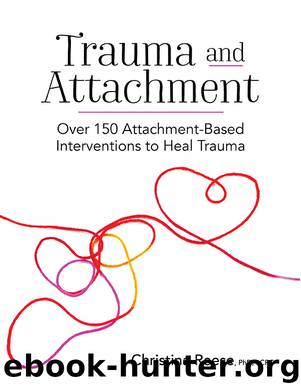Trauma and Attachment by Reese Christina;

Author:Reese, Christina;
Language: eng
Format: epub
Publisher: PESI
Published: 2023-09-23T00:00:00+00:00
INTERVENTIONS FOR HEALING
When a person has experienced neglect of any kind, they have lost the ability to trust others to meet their needs. Even though histories of neglect are rooted in childhood, when children could not take care of themselves, the experience often carries into adulthood, causing adults to have difficulty trusting others to take care of them. In turn, they may experience high stress or anxiety as they try to independently meet all of their own needs. They may also struggle to form attuned, trust-based relationships and often experience relationship dissatisfaction as they attempt to meet their own needs but ignore the needs of their partner. Their partner may even want to end the relationship. To heal from childhood neglect, it is important to recognize how this trauma continues to impact the client today. Use the Feeling Taken Care of Again worksheet with adult clients to explore these concepts and to identify areas where they are not trusting others.
Children who have experienced neglect can struggle to differentiate between adult and child roles. In order to help them understand the roles held by children versus adults, clinicians can use the Roles and Relationships worksheet. When a parent places a child in an adult role, this can be confusing for the child. This worksheet gives the child and the parent clarification. Based on the childâs answers, ask follow-up questions about the roles they play at home. In addition, encourage the child to share their answers with parents in the context of a family session, as doing so reinforces the notion that there are roles that children and adults need to fill.
In addition, the Roles and Places worksheet can help children understand the different roles that may be required of them at home versus at school (or in the community). There may be different rules or expectations in each setting, and this worksheet can assist them in coming to the realization that they can act different ways in different environments. For example, if a parent allows a child to curse at home, but they are not allowed to do so at school, then it is important to help that child recognize these different rules and expectations. The specific âenvironmentâ columns are intentionally left blank on the worksheet so the child can compare a variety of environments (e.g., home versus school, home versus summer camp, school versus summer camp, one parentâs home versus the other). It may be helpful to have a few different hats in your office that children can alternate wearing as they talk about their different roles in different places. This provides children with a visual and concrete representation of a more abstract concept. As children go through their day, they may be able to visualize themselves changing âhatsâ as they did in your office.
The I Am a Survivor worksheet is intended to help adults process their own experience of neglect. It uses a strength-based approach to help them think about how the trauma changed their personality, and it may
Download
This site does not store any files on its server. We only index and link to content provided by other sites. Please contact the content providers to delete copyright contents if any and email us, we'll remove relevant links or contents immediately.
Rewire Your Anxious Brain by Catherine M. Pittman(17630)
Talking to Strangers by Malcolm Gladwell(11966)
The Art of Thinking Clearly by Rolf Dobelli(8910)
Mindhunter: Inside the FBI's Elite Serial Crime Unit by John E. Douglas & Mark Olshaker(7884)
Becoming Supernatural by Dr. Joe Dispenza(7152)
Change Your Questions, Change Your Life by Marilee Adams(6694)
The Road Less Traveled by M. Scott Peck(6678)
Nudge - Improving Decisions about Health, Wealth, and Happiness by Thaler Sunstein(6677)
The Lost Art of Listening by Michael P. Nichols(6521)
Enlightenment Now: The Case for Reason, Science, Humanism, and Progress by Steven Pinker(6442)
Win Bigly by Scott Adams(6351)
Mastermind: How to Think Like Sherlock Holmes by Maria Konnikova(6287)
The Way of Zen by Alan W. Watts(5839)
Daring Greatly by Brene Brown(5687)
Big Magic: Creative Living Beyond Fear by Elizabeth Gilbert(4772)
Grit by Angela Duckworth(4769)
Men In Love by Nancy Friday(4377)
Flow by Mihaly Csikszentmihalyi(4087)
The Four Tendencies by Gretchen Rubin(4052)
